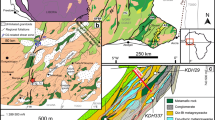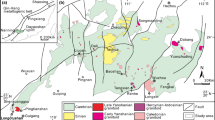Abstract
We determined the boron isotope and chemical compositions of tourmaline from the Hira Buddini gold deposit within the Archean Hutti-Maski greenstone belt in southern India to investigate the evolution of the hydrothermal system and to constrain its fluid sources. Tourmaline is a minor but widespread constituent in the inner and distal alteration zones of metabasaltic and metadacite host rocks associated with the hydrothermal gold mineralization. The Hira Buddini tourmaline belongs to the dravite–schorl series with variations in Al, Fe/(Fe+Mg), Ca, Ti, and Cr contents that can be related to their host lithology. The total range of δ11B values determined is extreme, from −13.3‰ to +9.0‰, but 95% of the values are between −4 and +9‰. The boron isotope compositions of metabasalt-hosted tourmaline show a bimodal distribution with peak δ11B values at about −2‰ and +6‰. The wide range and bimodal distribution of boron isotope ratios in tourmaline require an origin from at least two isotopically distinct fluid sources, which entered the hydrothermal system separately and were subsequently mixed. The estimated δ11B values of the hydrothermal fluids, based on the peak tourmaline compositions and a mineralization temperature of 550°C, are around +1 and +10‰. The isotopically lighter of the two fluids is consistent with boron released by metamorphic devolatilization reactions from the greenstone lithologies, whereas the 11B-rich fluid is attributed to degassing of I-type granitic magmas that intruded the greenstone sequence, providing heat and fluids to the hydrothermal system.






Similar content being viewed by others
References
Barth S (1993) Boron isotope variations in nature: a synthesis. Geologische Rundschau 82:640–651
Beckinsale R, Drury S, Holt R (1980) 3,360-Myr old gneisses from the South Indian craton. Nature 238:469–470
Biswas SK (1990) Gold mineralisation in Uti Block of Hutti-Maski Supracrustal belt, Karnataka. J Geol Soc India 36:79–89
Burrows D, Spooner E (1987) Generation of magmatic H20-CO2 fluid enriched in Mo, Au and W within an Archean sodic granodiorite stock, Mink Lake, North Western Ontario. Econ Geol 82:1931–1957
Cantanzaro EJ, Champion C, Garner E, Marinenko G, Sappenfield K, Shields W (1970) Boric acid: isotopic and assay standard reference materials. National Bureau of Standards (US), Special Publication 260:70
Chadwick B, Vasudev VN, Ahmed N (1996) The Sandur Schist Belt and its adjacent plutonic rocks: implications for late Archaean crustal evolution in Karnataka. J Geol Soc India 47:37–57
Chadwick B, Vasudev VN, Hedge GV (2000) The Dharwar craton, southern India, interpreted as the result of Late Archaean oblique convergence. Precambrian Res 99:91–111
Chardon D, Peucat J-J, Jayananada M, Choukroune P, Fanning CM (2002) Archean granite-greenstone tectonics at Kolar (South India): interplay of diapirism and bulk inhomogeneous contraction during juvenile magmatic accretion. Tectonics 21:1–17
Chaussidon M, Jambon A (1994) Boron content and isotopic composition of oceanic basalts: geochemical and cosmochemical implications. Earth Plan Sci Lett 121:277–291
Dyar MD, Taylor ME, Lutz TM, Francis CA, Guidotti CV, Wise M (1998) Inclusive chemical characterization of tourmaline: Mössbauer study of Fe valence and site occupancy. Am Mineral 83:848–864
Dyar MD, Wiedenbeck M, Robertson D, Cross LR, Delany JS, Ferguson K, Francis CA, Grew ES, Guidotte CV, Hervig RL, Hughes JM, Husler J, Leeman WP, McGuire AV, Rhede D, Rothe H, Paul RL, Richards I, Yates M (2001) Reference minerals for microanalyses of light elements. Geostandard Newslett 25:441–463
Eilu P, Mathison C, Groves D, Allardyce W (1999) Atlas of alteration assemblages, styles and zoning in orogenic lode-gold deposits in a variety of host rock and metamorphic settings. Geology and Geophysics Department (Centre for Strategic Mineral Deposits) and University of Western Australia Extension. The University of Western Australia Publication, p 50
Friend C, Nutman A (1991) SHRIMP U-Pb geochronology of the Closepet Granite and Peninsular Gneiss, Karnataka, South India. J Geol Soc India 38:357–368
Giritharan TS, Rajamani V (1998) Geochemistry of metavolcanics of the Hutti-Maski schist belt, South India: implications to gold metallogeny in the Eastern Dharwar Craton. J Geol Soc India 51:583–594
Groves DI (1993) The crustal continuum model for late-Archaean lode-gold deposits of the Yilgarn Block, Western Australia. Miner Depos 28:366–374
Groves DI, Phillips GN (1987) The genesis and tectonic control on Archaean gold deposits of the Western Australian shield: a metamorphic replacement model. Ore Geol Rev 2:287–322
Hawthorne FC, Henry DJ (1999) Classification of the minerals of the tourmaline group. Eur J Mineral 11:201–215
Hellmann A, Kolb J, Meyer MF (2005) Physikochemische Bedingungen während amphibolitfazieller hydrothermaler Goldmineralisation—Hira Buddinni, Indien. Berichte der Deutschen Mineralogischen Gesellschaft, Beih. z. Eur J Mineral 17:54
Henry DJ, Dutrow BL (1996) Metamorphic tourmaline and its petrologic application. Rev Miner 33:502–558
Henry DJ, Guidotti CV (1985) Tourmaline as a petrogenetic indicator mineral: an example from the staurolite-grade metapelites of NW Maine. Am Mineral 70:1–15
Hervig RL, London D, Morgan GB, Wolf MB (1997) Large boron isotope fractionation between hydrous vapor and silicate melt at igneous temperatures. 7th Annual VM Goldschmidt Conference, Lunar Planetary Inst, Houston, LPI Contribution, no. 921, pp 93–94
Hervig RL, Moore GM, Williams L, Peacock SM, Holloway JR, Roggensack K (2002) Isotopic and elemental partitioning between hydrous fluid and silicate melt. Am Mineral 87:769–774
Jayananda M, Moyen J-F, Martin H, Peucat J-J, Auvray B, Mahabaleswar B (2000) Late Archaean (2550-2520 Ma) juvenile magmatism in the Eastern Dharwar craton, southern India: constraints from geochronology, Nd–Sr isotopes and whole rock geochemistry. Precambrian Res 99:225–254
Jiang S-Y, Palmer MR (1998) Boron isotope systematics of tourmaline from granites and pegmatites: a synthesis. Eur J Mineral 10:1253–1265
Jiang S-Y, Palmer MR, Slack JF, Shaw DR (1999) Boron isotope systematics of tourmaline formation in the Sullivan Pb–Zn–Ag deposit, British Columbia, Canada. Chem Geol 158:131–144
Jiang S-Y, Palmer MR, Yeats CJ (2002) Chemical and boron isotopic compositions of tourmaline from the Archean Big Bell and Mount Gibson gold deposits, Murchison Province, Yilgarn Craton, Western Australia. Chem Geol 188:229–247
King R, Kerrich R (1989) Strontium isotope compositions of tourmaline from lode gold deposits of the Archean Abitibi greenstone belt (Ontario-Quebec, Canada): implications for source reservoirs. Chem Geol 79:225–240
Kolb J, Rogers A, Meyer F (2005) Relative timing of deformation and two-stage gold mineralization at the Hutti Mine, Dharwar Craton, India. Mineralium Deposita 40:156–174
Kolb J, Rogers A, Meyer F, Vennemann T (2004) Development of fluid conduits in the auriferous shear zones of the Hutti Gold Mine, India: evidence for spatially and temporally heterogeneous fluid flow. Tectonophysics 378:65–84
London D (1997) Estimating abundances of volatile and other mobile components in evolved silicic melts through mineral-melt equilibria. J Petrol 38:1691–1706
Manikyamba C, Naqvi S, Mohan M, Rao T (2004) Gold mineralisation and alteration of Penakacherla schist belt, India, constraints on Archaean subduction and fluid processes. Ore Geol Rev 24:199–227
McCuaig T, Kerrich R (1998) P-T-t deformation fluid characteristics of lode-gold deposits: evidence from alteration systematics. Ore Geol Rev 12:381–453
Meyer C, Wunder B, Meixner A, Romer R, Heinrich W (2007) Experimental study on the B-isotope fractionation between tourmaline and fluid: a re-investigation. Geochim Cosmochim Acta 71:A659
Mishra B, Pal N, Sarbadhikari A (2005) Fluid inclusion characteristics of the Uti gold deposit, Hutti-Maski greenstone belt, southern India. Ore Geol Rev 26:1–16
Müller A, Groves D (1991) The classification of Western Australian greenstone-hosted gold deposits according to wallrock-alteration mineral assemblages. Ore Geol Rev 6:291–331
Nesbitt BE, Muehlenbachs K (1989) Geology, geochemistry and genesis of mesothermal lode gold deposits in the Canadian Cordillera: evidence for ore formation from evolved meteoric water. Econ Geol Monogr 6:501–509
Pal N, Mishra B (2002) Alteration geochemistry and fluid inclusion characteristics of the greenstone-hosted gold deposit of Hutti, Eastern Dharwar Craton, India. Miner Depos 37:722–736
Palmer MR, London D, Morgan VI GB, Babb HA (1992) Experimental determination of fractionation of 11B/10B between tourmaline and aqueous vapor: a temperature- and pressure dependent isotopic system. Chem Geol 101:123–129
Palmer MR, Slack JF (1989) Boron isotopic composition of tourmaline from massive sulfide deposits and tourmalinites. Contrib Mineral Petrol 103:434–451
Palmer MR, Swihart GH (1996) Boron isotope geochemistry: an overview In: Grew ES, Anovitz LM (eds) Boron: mineralogy, petrology and geochemistry. Mineralogical Society of America, Reviews in Mineralogy, Washington 33, pp 709–744
Ridley J, Mikucki E, Groves D (1996) Archean lode-gold deposits: fluid flow and chemical evolution in vertically extensive hydrothermal systems. Ore Geol Rev 10:295–317
Rogers A, Kolb J, Meyer F, Armstrong R (2007) The tectono-magmatic evolution of the Hutti-Maski Greenstone Belt, India: constrained using geochemical and geochronological data. J Asian Earth Sci 31:55–70
Roy A (1979) Polyphase folding deformation in the Hutti-Maski schist belt, Karnataka. J Geol Soc India 20:598–607
Roy A (1991) The geology of gold mineralisation at Hutti in Hutti-Maski schist belt, Karnataka, India. Indian Miner 45:229–250
Siddaiah N, Rajamani V (1989) The geologic setting, mineralogy, geochemistry and genesis of gold deposits of the Archean Kolar schist belt, India. Econ Geol 84:2155–2172
Slack JF (1996) Tourmaline associated with hydrothermal ore deposits In: Palmer MR, Swihart GH (eds) Boron isotope geochemistry: an overview. Mineralogical Society of America, Reviews in Mineralogy, USA, pp 559–644
Smith MP, Yardley BWD (1996) The boron isotopic composition of tourmaline as a guide to fluid processes in the southwestern England orefield: an ion microprobe study. Geochim Cosmochim Acta 60:1415–1427
Spivack AJ, Berndt ME, Seyfried WEJ (1990) Boron isotope fractionation during supercritical phase separation. Geochim Cosmochim Acta 54:2337–2339
Srikantia S (1995) Geology of the Hutti-Maski greenstone belt In: Curtis L, Radhakrishna B (eds) Hutti gold mine into the 21st century. Geological Society of India, Bangalore, pp 8–27
Tonarini S, Pennisi M, Adorni-Braccesi A, Dini A, Ferrara G, Gonfiantini R, Wiedenbeck M, Gröning M (2003) Intercomparison of boron isotope and concentration measurements. Part I: Selection, preparation and homogeneity tests of the intercomparison materials. Geostandard Newslett 27:21–39
Vasudev VN, Chadwick B, Nutman AP, Hedge GV (2000) Rapid development of the Late Archaen Hutti schist belt, northern Karnataka: implications of new field data and SHRIMP U/Pb zircon ages. J Geol Soc India 55:529–540
Wang LG, McNaughton NJ, Groves DI (1993) An overview of the relationship between granitoid intrusions and gold mineralization in the Archaean Murchison Province, Western Australia. Miner Depos 28:482–494
Wolf M, London D (1997) Boron in granitic magmas: stability of tourmaline in equilibrium with biotite and cordierite. Contrib Mineral Petrol 130:12–30
Wyman D, Kerrich R (1988) Alkaline magmatism, major structures and gold deposits: implications for greenstone belt metallogeny. Econ Geol 83:454–461
Acknowledgments
Oona Appelt is acknowledged for her help during electron microprobe work, and Ilona Schäpan provided assistance in the SIMS analyses. The authors would like to thank S.-Y. Jiang and an anonymous referee for their helpful comments on the manuscript.
Author information
Authors and Affiliations
Corresponding author
Additional information
Editorial handling: Bernd Lehmann
Electronic supplementary material
Below is the link to the electronic supplementary material.
ESM Fig. 1
(GIF 17.8 kb)
ESM Table 1
Location and sample description from the Hira Buddini gold mine (XLS 23 KB)
ESM Table 2
Electron microprobe analyses and site assignments of tourmaline from the Hira Buddine gold mine (XLS 119 KB)
ESM Table 3
Boron isotope results on reference tourmalines (XLS 31 KB)
Rights and permissions
About this article
Cite this article
Krienitz, M.S., Trumbull, R.B., Hellmann, A. et al. Hydrothermal gold mineralization at the Hira Buddini gold mine, India: constraints on fluid evolution and fluid sources from boron isotopic compositions of tourmaline. Miner Deposita 43, 421–434 (2008). https://doi.org/10.1007/s00126-007-0172-0
Received:
Accepted:
Published:
Issue Date:
DOI: https://doi.org/10.1007/s00126-007-0172-0




